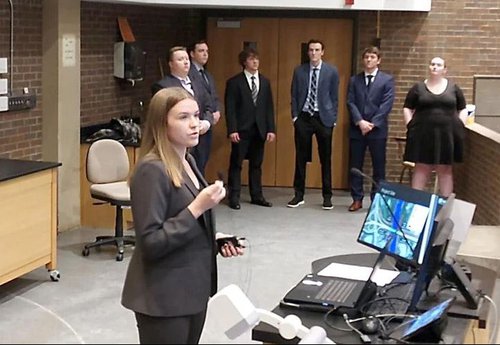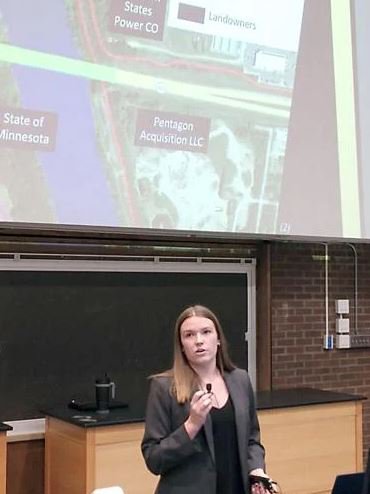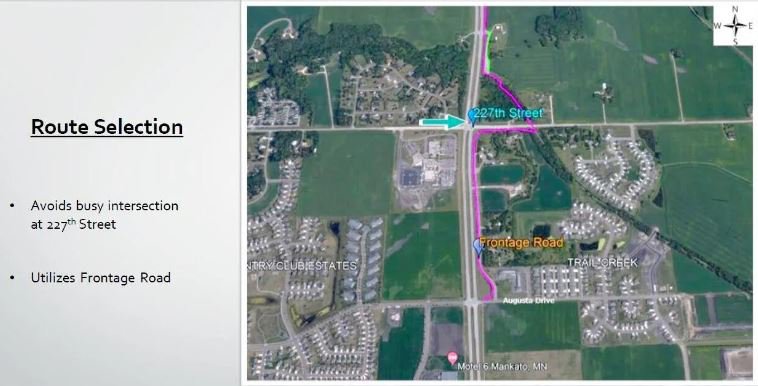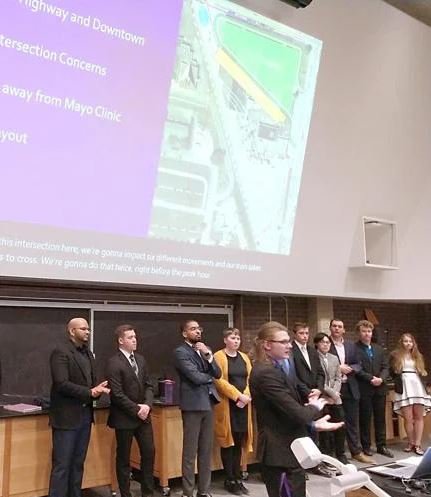This article was originally published on Mankato Free Press and authored by Mark Fischenich. See the original article here.

Anyone glancing into the large lecture hall in Minnesota State University’s Trafton Center at 6 p.m. Tuesday and Wednesday would have immediately suspected something momentous was about to occur.
Dressed in suits, ties and dresses, the soon-to-graduate civil engineering students were looking exceptionally sharp. And they were looking equally nervous.
A year in the making, the public presentation of their senior capstone design project is the culmination of their college education in the way an NFL season reaches its climax with the Super Bowl or a Broadway musical production comes to a head on opening night.
“We have probably practiced this presentation, oh, 50 times,” said senior Molly Hill, of Chisago City. “Seriously. So it was a little nerve-racking at the start.”
Hill was the project manager for a team of a dozen or so fellow civil engineering students who spent the first half of the 2022-23 academic year studying the feasibility of adding a second Highway 14 bridge over the Minnesota River in Mankato. The second half of the year, they designed every aspect of the bridge and prepared to present their work to a large audience that included professional engineers on hand to grill them during a lengthy Q&A.
Capstone projects are an element of most engineering programs, but MSU’s is unique in the emphasis the Department of Mechanical and Civil Engineering puts on solving actual infrastructure challenges in the Mankato area. Collaborating with cities, counties, state agencies and private companies, the department has assigned students to study and design new parks, explore massive road projects and contemplate the redevelopment of a sprawling former quarry.
“We do like to do real projects that have real clients, especially things that help our local community,” said Farhad Reza, the department chair and civil engineering professor.
Designing local infrastructure, even if the students’ work is more ambitious than what might ultimately be constructed, allows the young engineers to visit the actual site of a planned road or building and see for themselves the obstacles and opportunities. And it allows them to work with experienced civil engineers at the Minnesota Department of Transportation’s District 7 headquarters in Mankato, at public works departments for the city of Mankato and Blue Earth County and with private engineering firms.
Those agencies play the role of “clients” while the students serve as the engineering firm, and the role-playing involves repeated meetings throughout the year to provide project updates and seek client input.
Hill said she knows students at other engineering schools who do entirely simulated projects that are just a semester in length rather than two.
“At Mankato, we have a much more real-life senior engineering project experience,” she said. “We get to work directly with the client.”

In the case of Hill’s team, that was the Minnesota Department of Transportation — bridge engineer Andrew Lawver in particular. Lawver was impressively responsive, answering emailed questions the same day, inviting students to the MnDOT headquarters for assistance when they were struggling with a design and praising their final product.
“Working with MnDOT is great,” Hill said.
MSU’s approach is drawing more and more students to the program. This year’s graduating class, which will be either the second or third largest in the program’s history, was big enough that there were actually three capstone teams.
Hill’s worked with MnDOT on the Highway 14 bridge, which is scheduled for as much as $100 million in renovation and expansion in a decade or so. Another team, led by project manager Nolan Mattison, presented a somewhat more fanciful project Tuesday night — a passenger rail line from Mankato to Rochester to Winona. And on Wednesday night, a third team dubbing itself “Dynamic Engineering Consultants” showed their designs for a 7.4-mile multi-use trail between Mankato and St. Peter, something the Department of Natural Resources is hoping to build in coming years.
Each project demonstrated the full range of work required of civil engineers. The trail group, for instance, examined the feasibility of the trail and laid out justifications for constructing it, including survey results showing the popularity of bike trails, the documented increase in home values for houses near trails, and the mental and physical health benefits of outdoor recreation.

And they did the more expected engineering work. They designed the trail down to its foundation, a 416-foot bridge to carry the trail over a railroad corridor north of Mankato, and a tunnel to carry bikers and hikers beneath Highway 22 between Kasota and the Chankaska Creek Winery. They completed a construction schedule and a cost analysis ($5,736,298). Even educational message boards along the trail and seed mixes for native plants and wildflowers on trail slopes were included.
The dozen students worked with everyone from MnDOT and DNR officials to private engineering firms to Wells [a prefabrication manufacturer].
The technical proficiency, the collaboration and teamwork, and the communication skills demonstrated in the public presentation are all part of an engineering education.
“This actually hits all of the outcomes that we’re required to have for accreditation,” Reza said.
The passenger rail project might have been the most expansive of the three.
Nolan Mattison, the project manager, made the pitch for the value of rail service connecting Mankato and Rochester to the existing Amtrak service in Winona. He laid out the survey conducted by the group, their projections for ridership and the type of service envisioned.
Then the rest of the team explained their piece of the design. Henry Pagel and Mustafa Hussein laid out the plans for the train stations in Mankato, Rochester and Winona; Hagilan Mohan explained the soil conditions at the various sites; Josh James covered the stormwater management; Elissa Cook presented the environmental issues ranging from endangered and threatened species to stormwater pollution prevention. It went on and on.

The Highway 14 bridge group focused initially on the reasoning behind their conclusion that the best way to address the deteriorating bridge deck on the existing bridge is to build a second span just to the north. Once that span was constructed, highway traffic could be shifted to the new bridge while the old bridge is refurbished. And when both are completed, the highway would have additional lanes to handle future traffic growth even while providing a bike crossing connecting existing trails on both sides of the river.
After detailing their designs for bridge components, aesthetic additions to honor the area’s Dakota heritage and a budget projection of $75.6 million, Hill said the team was ready for questions.
As always, there were plenty. It’s something of a tradition for area engineers to show up for the presentations and pepper the students with detailed queries and challenges to their assumptions. Reza said many of the attendees are MSU engineering grads looking to give back a little of what they got when they were at the front of the lecture hall.
“Yeah, they do actually,” he said, laughing. “A lot of them went through it — they’re alumni. So they know we want them to get those tough questions. We don’t want it to be easy. So that will put them on their toes.”
While the students might have to make some pre-graduation adjustments to their projects based on audience feedback, the presentations are essentially the finish line of a four-year race.
As 8 p.m. approached, there was a pause in the hands being raised in the auditorium.
“OK, no more questions?” Hill said, a hopeful smile on her face that the final horn was about to sound.
“One more ...” a man said, raising his hand as the audience laughed at the change in the expression on Hill’s face.
The question had to do with alternative bidding processes, and Hill turned to her teammates. One quickly stepped up, suggesting that a design-build process could be advantageous considering the complexities of the project.
It was a rock-solid finale for the bridge team, which traded fist bumps as the audience completed evaluation forms.
Not everybody in the audience was an engineer. Brian and Amber Hill, of Chisago City, who once watched their daughter play hockey, were on hand to see her skate through an hourlong engineering presentation.
“I think it’s great,” Brian Hill said. “To be honest, I wish they had more of this when I was graduating. I think it will prepare them well for the real deal.”
Asked if the presentation was, for parents of an engineering student, the equivalent of attending a kid’s hockey game, Amber Hill laughed.
“Not exactly,” she said. “But still super interesting.”



